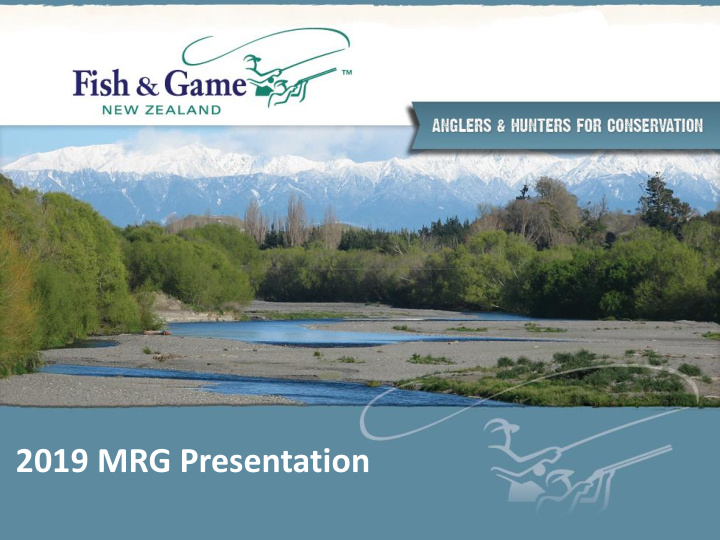



2019 MRG Presentation
Angling • The Manuherikia River is the 5th most fished river in Otago with over 2000 angler days reported (NAS 2014/15) It is ranked 49 th out of over 500 river fisheries in • NZ • It is classified as a regionally significant trout fishery
• Several different fisheries exist in the catchment – The mainstem can be divided into 3 sections • Above Falls Dam – backcountry characteristics • Between Falls Dam and the Ophir gorge (middle reach) • Below the Ophir gorge through to the confluence with the Clutha Mata-Au (lower reach) – Dunstan Creek and other tributaries – Large Irrigation Reservoir’s – Falls Dam, Poolburn and Manorburn
National Angler Survey • Angler usage in days Fishery 2014/15 2007/08 2001/02 1994/95 Mainstem 2,100 ± 820 1,880 ± 640 5,630 ± 2,060 3,570 ± 840 Dunstan Creek 210 ± 150 230 ± 170 40 ± 40 160 ± 140 Poolburn Dam 5,090 ± 1,280 3,650 ± 700 2,810 ± 600 2,270 ± 540 Manorburn Dam 1,240 ± 650 3,220 ± 610 2,350 ± 540 510 ± 130
Recreational Opportunities Spectrum Fishery Setting Activity Users Above Falls Dam Backcountry F, S, B L, R, N, I, C Falls Dam Natural F, S, B, T, H L, R, N, J Dunstan Creek Backcountry F, S, B L, R, N, C, J Below Falls Dam Rural F, S, B, H L, R, J, C Manorburn Res Natural F, S, B, T, H L, R, N, C, J Poolburn Res Natural F, S, B, T, H L, R, N, C, J Activity: Fly(F), Spin(S) and Bait(B) fishing, Trolling(T) and Waterfowl hunting(H) Users: Local(L), regional(R), national(N), international(I), commercial(C) and junior(J)
Values of NZ Angling • Unwin survey on what makes a river enjoyable – Manuherikia River – Mean enjoyment score out of 5 90 th percentile is 2.92 and mean is 2.38 • – % of respondents who placed the relevant attribute in their top 3 for the Manuherekia Mean Close to Close to Ease of Area of Scenic Wilderness Angling Good catch Anticipate enjoyment home holiday access fishable beauty feeling challenge rate large fish score home water 2.09 32% 17% 55% 34% 14% 8% 26% 17% 0
• Sports Fish – Brown Trout – most abundant species and widely distributed – Rainbow trout – less abundant than brown with a similar distribution – Brook Char – widely distributed in headwaters and smaller tribs – Chinook Salmon – occasionally documented in lower river – Perch – occasionally documented in lower river • Fish and Game have a philosophy of relying on wild populations of sports fish
Sports Fish Spawning • Spawning is difficult to monitor as fish can spawn in a variety of places and only when conditions are suitable – almost impossible to predict • Spawning in the upper catchment is widespread, providing recruitment both into the Upper Manuherikia River and downstream into Falls Dam reservoir. • Spawning is widespread across the Lower Manuherikia catchment with many tributaries and streams, as well as the mainstem river, providing important sports fish spawning habitat.
Spawning sites identified • Upper catchment – Pig Gully Creek, Johnstone’s Creek , Spring Creek, Healey’s Creek , Hut Creek, Rocks Creek, West Branch, Manuherikia River (mainstem) • Lower Catchment – Manor Burn, Chatto Creek, Lauder Creek, Ida Burn, Dunstan Creek, Cambrian Creek, Thomson’s Creek , Miller’s Creek , Home Hills Run Creek, Shepherds Creek, Pleasant Valley Creek, Hills Creek, Lower Pool Burn, Becks Creek, Young Hill Creek, Mata Creek, Gorge Creek
• Poolburn Reservoir Spawning – largely reliant on spawning in Cranky Woman Creek and Pool Burn Creek • Manorburn Reservoir – has a good area of spawning habitat available and the fishery has been observed to be very productive
• A review of fishery information is suggesting rainbows are more prevalent than had been thought in the lower reaches
Hunting & Gamebirds • Waterfowl – Mallard – Grey – Shoveler – Paradise – Pukeko
Population trend counts • Draining of wetlands will have had an impact on populations but irrigation dams will provide some habitat
• Upland gamebirds such as California Quail are present in the catchment • Pukeko and paradise ducks are iconic NZ bird species
• Protected species – not hunted – Pukeko – Grey Teal – Scaup
Our experience with the catchment • Highly modified catchment which has been of concern to Fish & Game and the Acclimatisation Society for decades • A degraded ecosystem still in parts
Historical Flow Data
Desirable outcomes • Restoration of ecosystems • Diverse, productive, resilient habitat • Good water quality • Recreational opportunities for all • Excellent mahinga kai and food gathering opportunities • Natural form & character
More than minimum flows • FMU process is about more than minimum flows • F&G would like to see scope that includes wetlands, vegetation protection, water yield, water quality, gravel management ect. • Social and economic analyses which consider more than reliability of supply and recognize out of catchment users
A path forward? • Community proposition developed through MCWSG – Vision “A thriving valley community that uses its water resources in a sustainable and cooperative way” – Fundamental Principles and considerations • Sustainable management, Guardianship, Kaitiakitanga, Priority uses, Natural character, Biodiversity, Water quality and effects, Integration, Infrastructure, Access, Community and commercial use
Recommend
More recommend